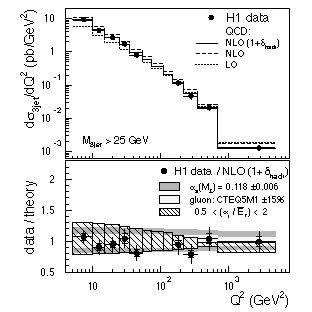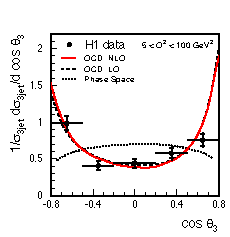Three Jet Production in Deep-Inelastic Scattering at HERA
|
Jets, collimated sprays of particles emerging from the
interaction of particle beams have long been interpreted as the echo of
the underlying interaction at a microscopic level. Quarks and gluons make
up the proton. In electron-proton interactions at HERA, the electron strikes
a quark and expels it from the proton. Shouldn't then every electron-proton
collision end up in a scattered electron and a jet emerging from the struck
quark?
Not quite. The quark travels in the strong colour field
inside the proton. These fields may become so strong locally that a gluon
is radiated off the accelerated quark much alike the electromagnetic field
surrounding an accelerated electric charge. The gluon may thus convert
into a quark anti-quark pair, which may radiate itself and so on. Some
of these quarks and gluons may be so energetic that additional jets are
expelled from the proton. Single jets are abundant at HERA. Interactions
producing two jets have also been studied in detail. These so called hard
processes in which all of the participating partons acquire sufficient
energy to leave the interaction region are theoretically calculable in
perturbative Quantum Chromodynamics, pQCD. The theory has been tested both
in electron-positron, electron-proton and proton-proton collisions.
The H1 experiment has now selected a number of events
that show a distinct separation of the expelled particles into three jets
as recorded in the experimental apparatus. These events are attributed
to processes in which at least three quarks and gluons are involved. Since
three jets are produced the strong interaction must have "worked" on these
events several times. The rate of these events, considerably smaller than
those in which a simple quark jet is expelled from the proton, is hence
suppressed by several orders. However, because the involved process of
interaction the sensitivity for tests of the theory is particularly large.
Kinematic Dependence of the Production Rate
|
 |
The measurements can hence be compared to the expectation
from pQCD in a very sensitive manner. Such calculations have just become
available in the next reliable degree of approximation, i.e. expansion
in the coupling strength (in next-to-leading order calculation). The adjacent
figure shows the rate of such events as a function of the distance from
the struck quark. (The scale Q2 is a convenient quantity that
can be extracted from the experimental data. Large Q2 imply
short distances).
The rate of these events is compared to the calculations
in the adjacent figure (top). It is astounding that the rate of such events
is very well predicted from the theoretical calculation over orders of
magnitude in the distance scale. Pictorially speaking this implies that
there is a good understanding of how a quark "dresses up" in a strongly
interacting cloud of gluons and quarks inside the proton.
The experimental uncertainties for this distinct final
state signature is small, they become smaller the smaller the distance
is probed. |
 |
Angular Distribution
How do we know that QCD is at work? If the three jets just formed
in a random fashion in the proton they would populate the available phase
space volume in a uniform manner. The graph on the left shows the angular
distribution measured between jets and production plane. This distribution
is well described by the theory of strong interactions (QCD) while the
phase space model does not describe the experimental observation.
|
Last
modified Sep 19, 2001

